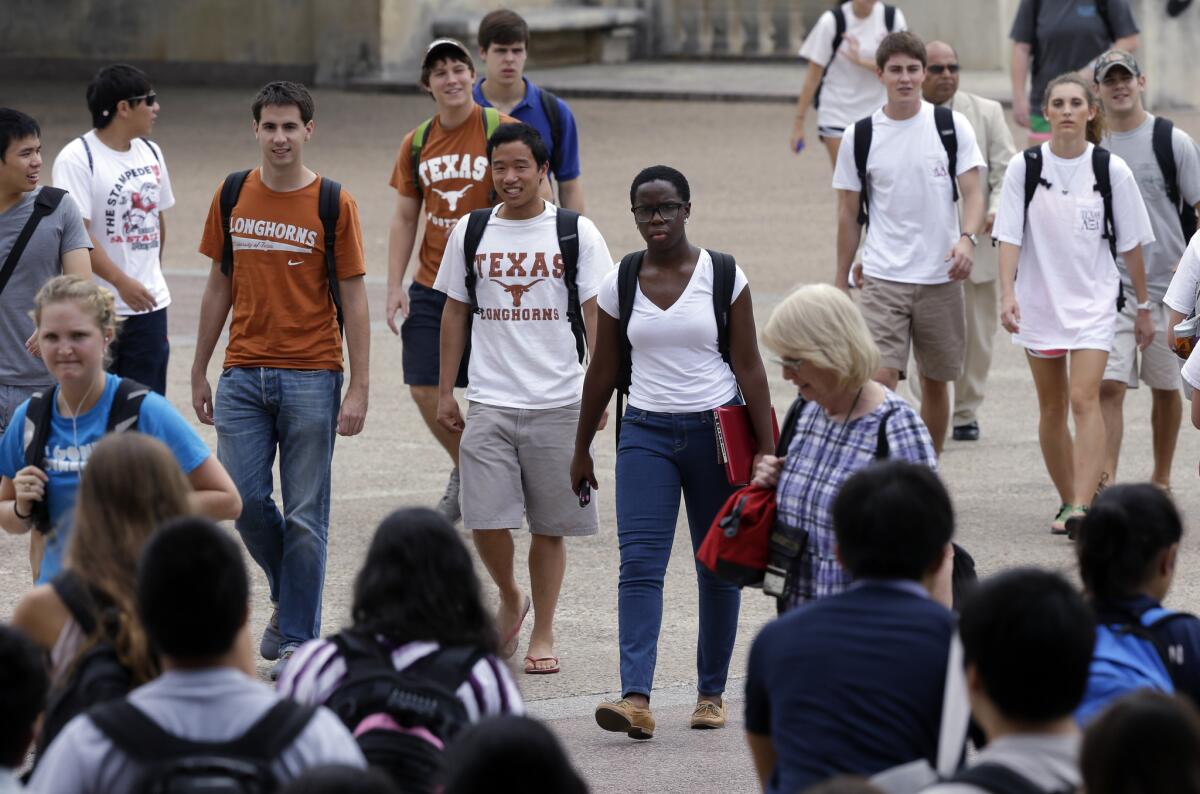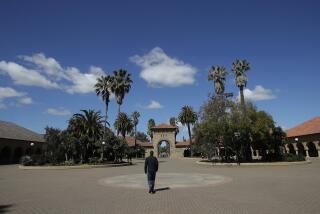Editorial: Supreme Court should avoid discouraging meaningful diversity in higher education

Students walk through the University of Texas at Austin campus in Austin, Texas in 2012.
This week, for the second time in three years, the Supreme Court will hear the claim of a disappointed white applicant to the University of Texas who objected to the fact that the university took account of race in filling some seats in its freshman class. It’s ominous that the court is revisiting the case of Abigail Fisher, who in 2008 failed to win a place at the university’s flagship campus at Austin.
The court seems unlikely to use this case to overrule its prior holdings that state universities may consider race as a “plus factor” in assembling a student body without violating the equal protection of the laws guaranteed by the Constitution. But even if it rules for Fisher on narrower grounds, it will embolden opponents of affirmative action and make universities think twice about aggressively pursuing diversity.
For the foreseeable future, especially at highly competitive universities, meaningful racial diversity will require some consideration of race in the admissions process.
Although many who have rallied to Fisher’s cause would be happy to have the court invalidate all racial preferences in admissions, she is making a narrower claim: that the University of Texas’ approach to college admissions violates the principle that race may be considered only as a last resort. The Supreme Court first heard her appeal in 2012, but returned the case to a federal appeals court with instructions to subject the university’s admissions plan to “strict scrutiny” in order to ensure that its use of race was “necessary to further a compelling governmental interest” and “narrowly tailored to that end.” The appeals court again ruled against Fisher, and she again appealed.
At the University of Texas, most freshmen are admitted automatically if they finish at the top of their high school graduating classes (when Fisher applied, that meant finishing in the top 10% of the class; currently the cutoff is the top 7%). Because so many schools in Texas are racially homogeneous, this guarantees that the freshman class will include a sizable number of minorities. But to fill the remaining places in the freshman class, the university employs what it calls a “holistic” process that considers a broad range of factors including race, socioeconomic status, extracurricular activities and community service. This process has allowed the university to enroll black and Latino (and white) students from high-achieving schools in prosperous areas who failed to finish at the top of their classes.
The university says that this “diversity within diversity” strategy produces the sort of “broad array of qualifications and characteristics” that contributes to a truly diverse learning environment. It also argues, persuasively, that a campus with minorities from different socioeconomic backgrounds helps to break down racial stereotypes. Fisher counters that the university’s approach fails to satisfy the Supreme Court’s demand that the use of race be “narrowly tailored,” but a federal appeals court disagreed — even after reconsidering the issue at the Supreme Court’s direction.
The Supreme Court could hold that, because the University of Texas enrolled many minority students through the top 10% program, race-conscious policies are unnecessary to achieve diversity. But that decision not only would be wrong in itself; it would send the message that the court is willing to second-guess the specifics of other affirmative-action programs.
The possibility of perpetual litigation could discourage colleges and universities from taking race into account not only to promote a diverse learning environment but also to compensate for the effects of racial discrimination and educational inequality. Redressing such inequalities is actually the most compelling argument for affirmative action, though not (unfortunately) the one the court has endorsed. Many minority students on college campuses already feel alienated, as recent protests at several institutions demonstrate. Race relations would fray further if universities were to cut back on their commitment to diversity for fear of litigation.
For the foreseeable future, especially at highly competitive universities, meaningful racial diversity will require some consideration of race in the admissions process. Beginning with the Bakke case in 1978, the Supreme Court repeatedly has held that the Constitution does not prevent such good-faith efforts. The court should get out of the business of micromanaging affirmative-action programs, and it can start by rejecting Fisher’s appeal.
Follow the Opinion section on Twitter @latimesopinion and Facebook
More to Read
A cure for the common opinion
Get thought-provoking perspectives with our weekly newsletter.
You may occasionally receive promotional content from the Los Angeles Times.










